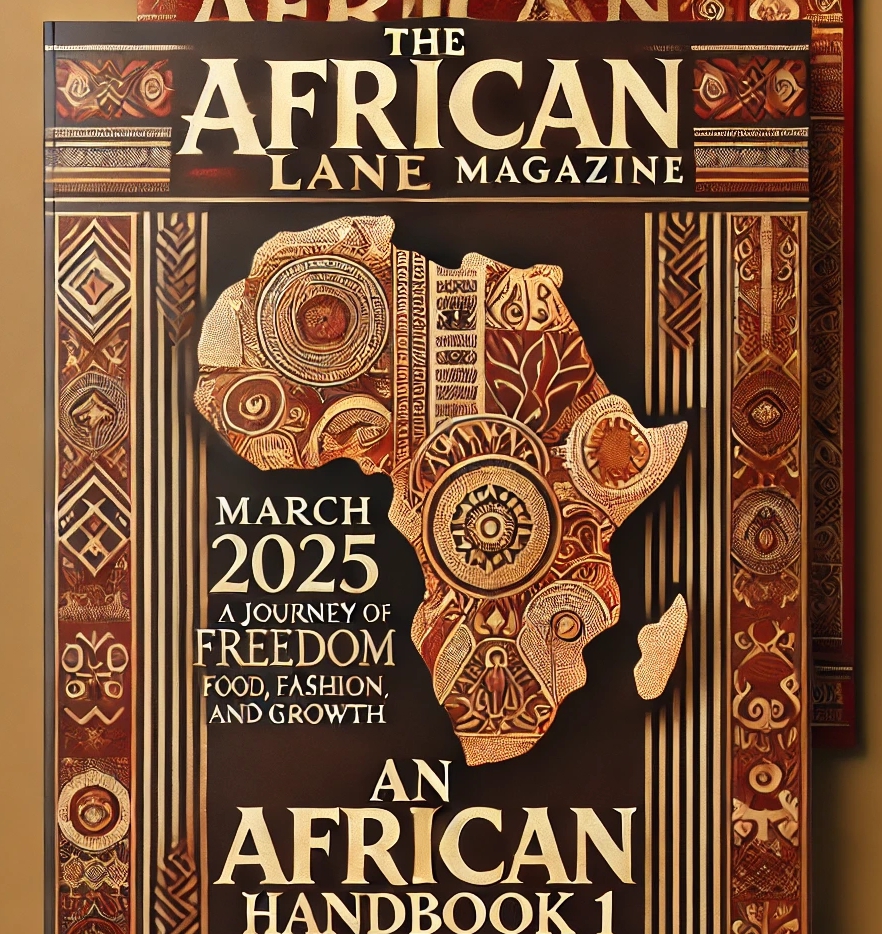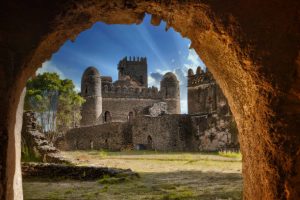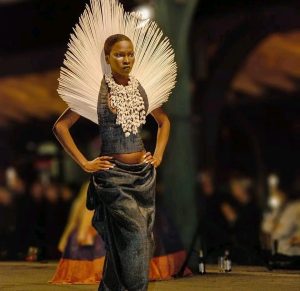Federal Democratic Republic of Ethiopia
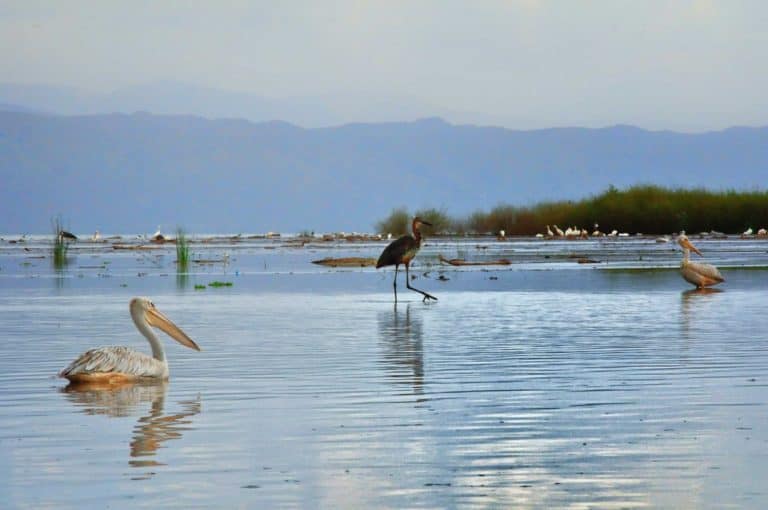
Ethiopia is a rugged landlocked country split by the Great Rift Valley. With archaeological finds dating back more than 3 million years, it’s a place of ancient culture. Among its important sites are Lalibela with its rock-cut Christian churches from the 12th–13th centuries. Aksum is the ruins of an ancient city with obelisks, tombs, castles and Our Lady Mary of Zion church.
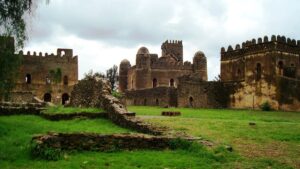
Aksum
It is known that this kingdom was one of the richest civilizations of the brown continent of that time,Its wealth and strength are due to the port of adul on the red sea.
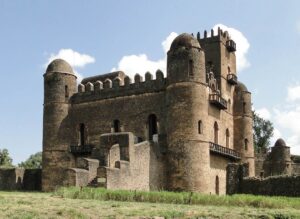
It location gives it strategic dominance as a jumping off point in the Horn of Africa, close to the Middle East and its markets. Bordering Eritrea, Somalia, Kenya, South Sudan, and Sudan, and has been using neighboring Djibouti’s main port for the last two decades. However, with the recent peace agreement with Eritrea, Ethiopia is set to resume accessing the Eritrean ports of Assab and Massawa for its international trade.
With more than 112 million people (2019), Ethiopia is the second most populous nation in Africa after Nigeria, and the fastest growing economy in the region. However, it is also one of the poorest, with a per capita income of $850. Ethiopia aims to reach lower-middle-income status by 2025.
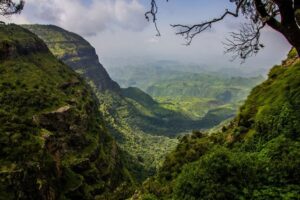
Source: Wildfrontuerstravel.com
According to World Bank, Ethiopia’s economy experienced strong, broad-based growth averaging 9.4% a year from 2010/11 to 2019/20, Ethiopia’s real gross domestic product (GDP) growth slowed down to 6.1% in 2019/20 due to COVID-19 (cornaviruspandemic. Industry, mainly construction, and services accounted for most of the growth. Agriculture was not affected by the COVID-19 pandemic and its contribution to growth slightly improved in 2019/20 compared to the previous year. Private consumption and public investment explain demand-side growth, the latter assuming an increasingly important role.
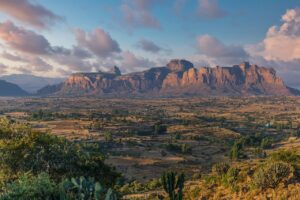
Photo: Framalicious/Shutterstock
This corner of northeastern Tigray almost resembles the American West, with its flat plains and distinct, mountainous rock formations reminiscent of Utah’s Monument Valley.
The consistent higher economic growth brought with it positive trends in poverty reduction in both urban and rural areas. The share of the population living below the national poverty line decreased from 30% in 2011 to 24% in 2016. The government has launched a new 10-year perspective plan which will run from 2020/21 to 2029/30. The plan aims to sustain the remarkable economic growth achieved under the Growth and Transformation Plans, while putting more emphasis on the private sector.
Background
Ethiopia is one of the world’s oldest countries, its territorial extent having varied over the millennia of its existence. In ancient times it remained centred on Aksum, an imperial capital located in the northern part of the modern state, about 100 miles (160 km) from the Red Sea coast. The present territory was consolidated during the 19th and 20th centuries as European powers encroached into Ethiopia’s historical domain. Ethiopia became prominent in modern world affairs first in 1896, when it defeated colonial Italy in the Battle of Adwa, and again in 1935–36, when it was invaded and occupied by fascist Italy. Liberation during World War II by the Allied powers set the stage for Ethiopia to play a more prominent role in world affairs. Ethiopia was among the first independent nations to sign the Charter of the United Nations, and it gave moral and material support to the decolonization of Africa and to the growth of Pan-African cooperation.
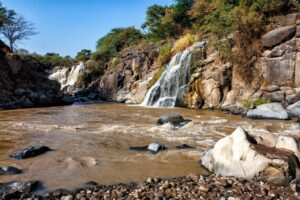
Photo: Henk Bogaard/Shutterstock
Located in the dry savanna of the Rift Valley, Awash National Park is home to a 500-foot-deep gorge, waterfalls, and the dormant volcano of Mount Fantale.
These efforts culminated in the establishment of the Organization of African Unity (since 2002, the African Union) and the United Nations Economic Commission for Africa, both of which have their headquarters in Addis Ababa.
Ethiopia is a multilingual nation, with around 80 ethnolinguistic groups, the four largest of which are the Oromo, Amhara, Somali and Tigrayans. Most people in the country speak Afroasiatic languages of the Cushitic or Semitic branches. Additionally, Omotic languages are spoken by ethnic minority groups inhabiting the southern regions. Nilo-Saharan languages are also spoken by the nation’s Nilotic ethnic minorities. Oromo is the most populous language by native speakers, while Amharic is the most populous by number of total speakers. Ge’ez remains important as a liturgical language for both the Ethiopian Orthodox Tewahedo Church and the Eritrean Orthodox Tewahedo Church and for the Beta Israel. A majority of the population adheres to Christianity (mainly the Ethiopian Orthodox Tewahedo Church and P’ent’ay), and the historical Kingdom of Aksum was one of the first states to officially adopt the religion. A third follow Islam, primarily Sunni. The country is the site of the Islamic Migration to Abyssinia and the oldest Muslim settlement in Africa, at Negash. A substantial population of Ethiopian Jews, known as Beta Israel, also resided in Ethiopia until the 1980s.The nation is a land of geographical contrasts, ranging from the vast fertile west, with its forests and numerous rivers, to the world’s hottest settlement of Dallol in its north.
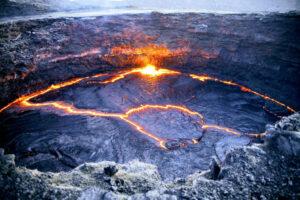
The Ethiopian Highlands are the largest continuous mountain ranges in Africa, and the Sof Omar Caves contains the largest cave on the continent. Ethiopia also has the second-largest number of UNESCO World Heritage Sites in Africa. The sovereign state is a founding member of the UN, the Group of 24 (G-24), the Non-Aligned Movement, the G77 and the Organisation of African Unity. Addis Ababa serves as the headquarters of the African Union, the Pan African Chamber of Commerce and Industry, the United Nations Economic Commission for Africa, the African Standby Force and many of the global NGOs focused on Africa.
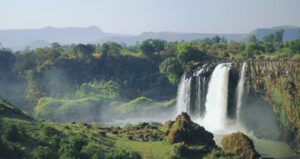
Close to the city of Bahir Dar you will find the incredible Blue Nile Falls. The locals call it Tis- Isat Falls (translated as “Smoke of Fire”) and it is the most impressive sight on either the Blue or White Nile. The falls stretch a quarter-mile wide during the flood season and drops into a gorge of more than 150 feet deep.
Ethiopia is an ecologically diverse country, ranging from the deserts along the eastern border to the tropical forests in the south to extensive Afromontane in the northern and southwestern parts. Lake Tana in the north is the source of the Blue Nile. It also has many endemic species, notably the gelada, the walia ibex and the Ethiopian wolf (“Simien fox”).
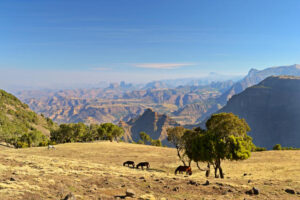
The wide range of altitude has given the country a variety of ecologically distinct areas, and this has helped to encourage the evolution of endemic species in ecological isolation.
According to the IMF, Ethiopia was one of the fastest growing economies in the world, registering over 10% economic growth from 2004 through 2009. It was the fastest-growing non-oil-dependent African economy in the years 2007 and 2008. In 2015, the World Bank highlighted that Ethiopia had witnessed rapid economic growth with real domestic product (GDP) growth averaging 10.9% between 2004 and 2014.
In 2008 and 2011, Ethiopia’s growth performance and considerable development gains were challenged by high inflation and a difficult balance of payments situation. Inflation surged to 40% in August 2011 because of loose monetary policy, large civil service wage increase in early 2011, and high food prices.[265] For 2011/12, end-year inflation was projected to be about 22%, and single digit inflation is projected in 2012/13 with the implementation of tight monetary and fiscal policies.

Of all the Rift Valley lakes, Lake Langano is the most developed for tourism, lying adjacent to the Abiata-Shals National Park that is dominated by the two lakes for which it is named. Lake Langano is 18 km long and 16 km wide and its soft brown waters are set against the blue backdrop of the Arsi Mountains, which soar to 4000 m. Although the area around the lake is largely deforested, a variety of wildlife live here including hippos, monkeys, baboons, warthogs, and a huge variety of birds.
Source:wildfrontierstravel.com
In spite of fast growth in recent years, GDP per capita is one of the lowest in the world, and the economy faces a number of serious structural problems. However, with a focused investment in public infrastructure and industrial parks, Ethiopia’s economy is addressing its structural problems to become a hub for light manufacturing in Africa. In 2019 a law was passed allowing expatriate Ethiopians to invest in Ethiopia’s financial service industry.
The best-known Ethiopian cuisine consists of various types of thick meat stews, known as wat in Ethiopian culture, and vegetable side dishes served on top of injera, a large sourdough flatbread made of teff flour.
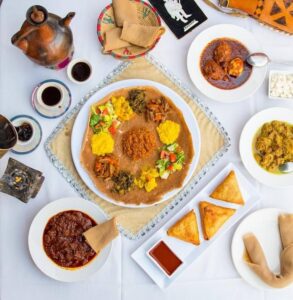
This is not eaten with utensils, but instead the injera is used to scoop up the entrées and side dishes. Almost universally in Ethiopia, it is common to eat from the same dish in the middle of the table with a group of people. It is also a common custom to feed others in your group with your own hands—a tradition referred to as “gursha“. Traditional Ethiopian cuisine employs no pork or shellfish of any kind, as both are forbidden in the Ethiopian Orthodox Christian, Islamic and Jewish faiths.
Chechebsa, Marqa, Chukko, Michirra and Dhanga are the most popular dishes from the Oromo. Kitfo, which originated among the Gurage, is one of the country’s most popular delicacies. In addition, Doro wot (ዶሮ ወጥ in Amharic) and Tsebehi derho (ጽብሒ ድርሆ
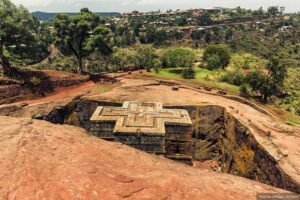
in Tigrinya), are other popular dishes, originating from northwestern Ethiopia.[citation needed] Tihlo (ጥሕሎ)—which is a type of dumpling—is prepared from roasted barley flour and originated in the Tigray Region. Tihlo is now very popular in Amhara and spreading further south.
First image: Source: flickr
Arba Minch
Named after the Amharic word for ‘forty springs,’ Arba Minch is an area of many tiny springs that bubble up from the ridge below them.
Source:https://www.worldbank.org/en/country/ethiopia/overview, Wikipedia, Britannica, http://travelanddestinations.com, http://Wildfrontuerstravel.com
